Aging Well Program: Memory
Click to try FREE for 15-Days.
This module contains games which train long-term memory on both visual and verbal dimensions.

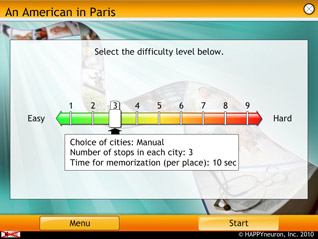
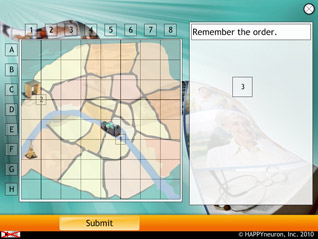
An American in Paris
The task
Time to get the guidebooks out because this game provides a splendid tour through eight of the greatest cities on earth, including Paris, Rome and London! This exercise is divided into two parts. In the first part, the patient has to memorize the names of famous monuments of a given city (Paris, Rome, London…), together with their location on a grid. He must also pay attention to the presented itinerary. In the second part, the monuments on the grid have to be replaced and the itinerary shown in the first part has to be reconstructed.
What it trains
This task trains the user's visual spatial perception as he has to form a mental image of the grid with all the information it contains. It also trains his visual spatial memory. Indeed, he has to store the mental images he has created in his mind in order to memorize the information and recall them effectively. In daily life, good visual-spatial skills are needed to orient oneself in a neighborhood, to retrace one's steps through a crowd, to remember landmarks, and also to be able to recognize that a person is in an unfamiliar environment.
Parameters
In this program, 9 levels have been specially selected to ensure an easy start and grant a regular progression.





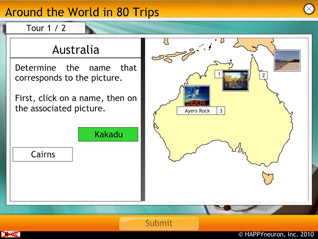
Around the World in 80 Trips
The task
In this exercise the subject embarks on a splendid tour through the most beautiful regions on earth. The exercise consists of memorizing the itineraries of tours that may be selected from a list of destinations. The patient must keep in mind the names of the places he visits, the images associated with those places, and the order of the landmarks visited. He has to recall those elements on a grid afterwards.
What it trains
This task trains the patient's visual and spatial memory pertaining to environmental information. He has to visualize pictures and written names (visual information), locate the pictures in space (spatial information) and then build a spatial relationship among the pictures. He will thus train his visual and spatial orientation and his perception skills. These are the skills that enable us to mentally manipulate and rotate information in space by taking different perspectives.
Parameters
In this program, 9 levels have been specially selected to ensure an easy start and grant a regular progression.



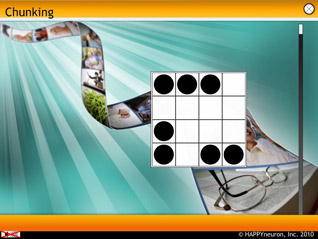

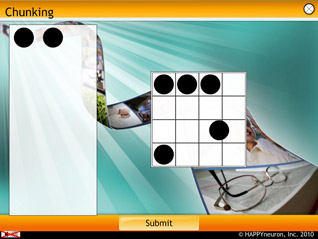
Chunking
The task
In this exercise, a grid is presented with several geometrical figures inside (circles or/and squares). The patient has to memorize the location of those elements and recall their position afterwards. Like all task for which it is necessary to memorize a great number of information it is essential to be used to grouping these pieces of information into individual categories or logical subcategories.
What it trains
This task trains the subject's visual and spatial perception and memory. A further aim is to practice his capacity to memorize by developing a strategy and not trying to learn by heart. Due to the vast amount of information he has to memorize, it is wiser to memorize elements by subgroups.
Parameters
In this program, 9 levels have been specially selected to ensure an easy start and grant a regular progression.



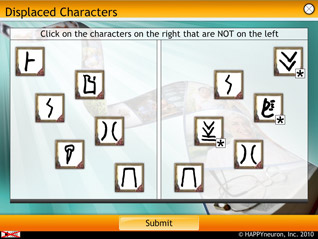
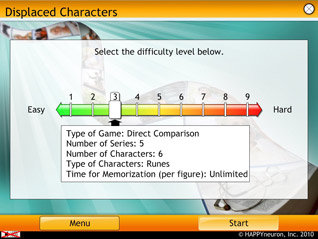

Displaced Characters
The task
In this exercise, the patient has to attentively observe figures in a list and select in a second list those figures that are not in the first list. At the beginning of the task, both lists will be on the same screen (direct comparison). They will later be on separate screens.
What it trains
This task helps the user to strengthen his visual and spatial perception and his memory by a process of distinguishing visual shapes and differences, as well as similarities amongst the characters. Memory is constantly called upon in varied ways such as to remember a pin code, a phone number, the title of a movie, an appointment, where you put your keys, or a historical event. Finally, this exercise also trains his concentration as he must pay attention to fine details in order to avoid confusion or omissions. Memory is needed everywhere in your daily life.
Parameters
In this program, 9 levels have been specially selected to ensure an easy start and grant a regular progression.



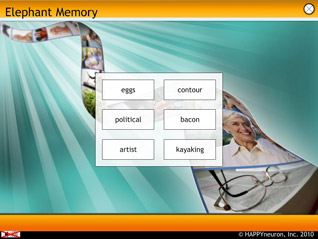
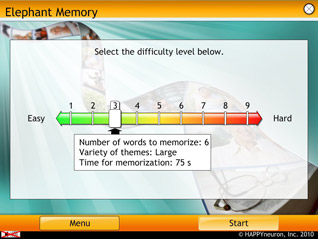
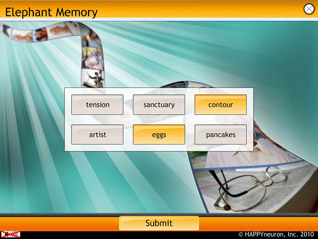
Elephant Memory
The task
The saying that elephants never forget is a true fact. Will the patient be able to build up memory over a few seconds or minutes and hold on to it? In this task, the user is presented with a grid of words to memorize. He will then be asked to recognize these same words from a longer list that also contains distraction or decoy words.
What it trains
In this exercise, the patient will practice his episodic memory through verbal material. Indeed, he has to store and retrieve several words. It also helps him build a strategy (place words into categories for example) to effectively remember a list of words without trying to learn it by heart as it takes too much mental effort.
Parameters
In this program, 9 levels have been specially selected to ensure an easy start and grant a regular progression.




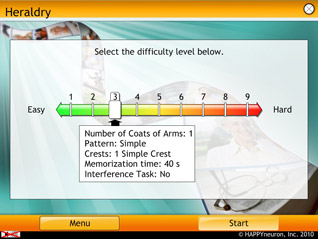
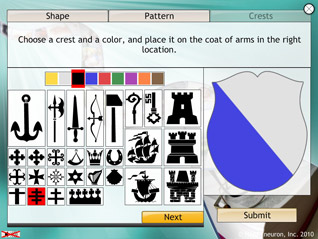
Heraldry
The task
The emergence of heraldry occurred across Western Europe almost simultaneously. Over time, distinct differences developed between the heraldic traditions of different countries. In this exercise, the patient is asked to memorize a coat of arms with all the elements that make it up. He therefore has to pay attention to shapes, colors, and patterns and to distinguish the various shields, tinctures, ordinaries, crests, and charges. The user will then be asked to recreate the coat of arms with its components.
What it trains
We rely on visual memory to remember the details of everything we see. Remembering city landmarks, recalling the logos on grocery products or bringing to mind the shapes of various traffic signs all entail use of this function. Spatial memory, by contrast, entails recalling objects in relation to one another; for example, locations on a map or the positions of stores in a shopping mall. This exercise therefore helps the patient strengthen his visual and spatial memory and perception as he has to explore and observe details of the coat of arms, link the components, and form a comprehensive mental image of the picture in order to recall it accurately. A further aim is to improve his visual attention and concentration skills.
Parameters
In this program, 9 levels have been specially selected to ensure an easy start and grant a regular progression.



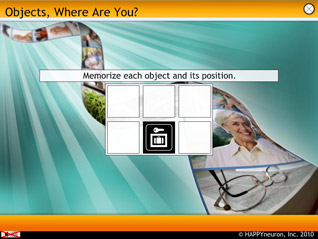
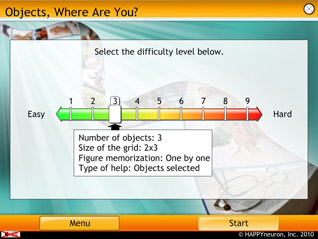
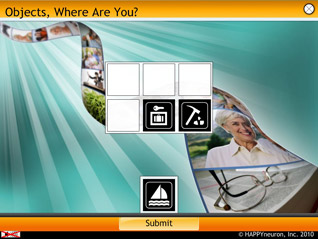
Objects, Where are You?
The task
Misplaced our keys, cell phone, and notebook all in one day? This classic memory game that we all enjoy has such simple rules but it can get very challenging if we haven't played it for a while. This exercise consists in memorizing the location of several pictures on a grid, and then recalling them in the same spot as the patient has previously seen them on the grid.
What it trains
A person who lives in a big city or has ever visited one will notice the omnipresent street signs, store logos and all the various symbols on a map that one needs to know in order to find one's way. This game can also help you remember the location of various objects in a room. This exercise trains the user's visual and spatial memory and perception as it is about creating associations between two types of information, an image and its location. He'll need to build a strategy to make a comprehensive association that makes their memorization easier. He also needs to pay attention to details and stay focused on the visual and spatial information.
Parameters
In this program, 9 levels have been specially selected to ensure an easy start and grant a regular progression.



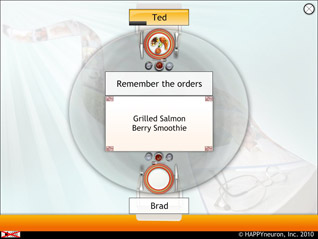
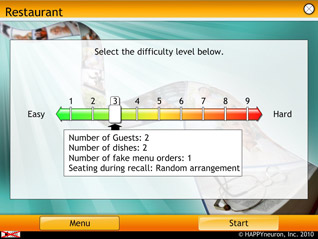
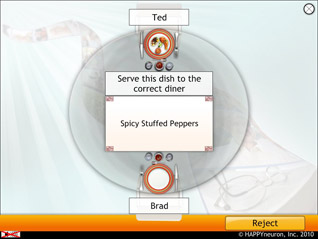
Restaurant
The task
Waiters in restaurants have the amazing ability to memorize all individual orders and to serve them all to the right people. In this exercise, the patient has to memorize the dishes associated with the names of different people. He must then recall the dishes and memorize who the dishes are associated with. The place of some people can change at the recall stage.
What it trains
This task trains the subject's verbal and visual memory. Indeed, he has to both memorize the orders of each person and remember the position of each of them around the table, knowing that this position may change. It therefore also trains his ability to mentally rotate the scene he has kept in his mind.
Parameters
In this program, 9 levels have been specially selected to ensure an easy start and grant a regular progression.



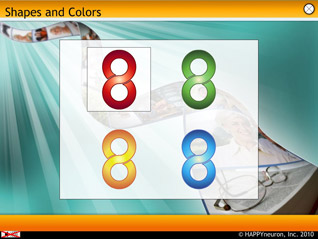
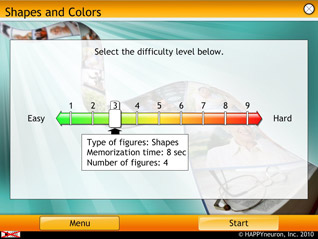
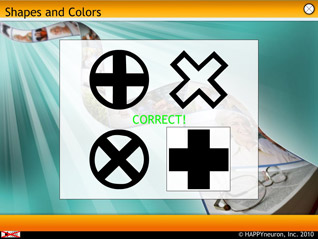
Shapes and Colors
The task
In this exercise, the patient has to memorize several figures of various shapes and colors and then recognize them among slightly different ones.
What it trains
Every day we encounter a myriad of different symbols and logos, including traffic signs, markers for shops and stores, even computer icons! This exercise demands attention to detail and the use of discrimination and differentiation for shapes. It calls upon the user's visual short-term memory. Visual short-term memory enables the brain to store visual information such as shapes and locations of objects. He then has to pay attention to details to discriminate the figures and build strategies in order to remember the ones he just has memorized.
Parameters
In this program, 9 levels have been specially selected to ensure an easy start and grant a regular progression.



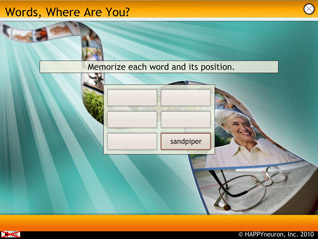
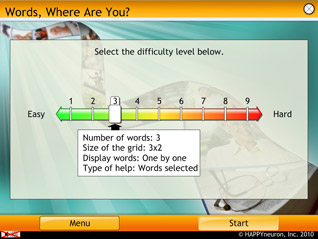
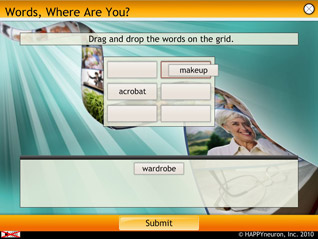
Words, Where are You?
The task
This exercise consists of memorizing the location of several words on a grid, and then recalling them in the same spot in a grid as the user has seen them previously.
What it trains
Verbal memory is an essential skill for remembering conversations, doing crossword puzzles or keeping track of written material of any sort such as shopping lists or key elements of a novel. Further, we rely upon spatial memory when we try to recall the location of shops on a street, products in a grocery store or a friend's house in a neighborhood. This exercise trains the patient's visual and spatial memory and perception as it is about creating associations between two types of information, a word and its location. He needs to build a strategy to make a comprehensive association that would make their memorization easier. Then, he needs to be attentive and stay focused on the visual and spatial information.
Parameters
In this program, 9 levels have been specially selected to ensure an easy start and grant a regular progression.



Click to try FREE for 15-Days.
